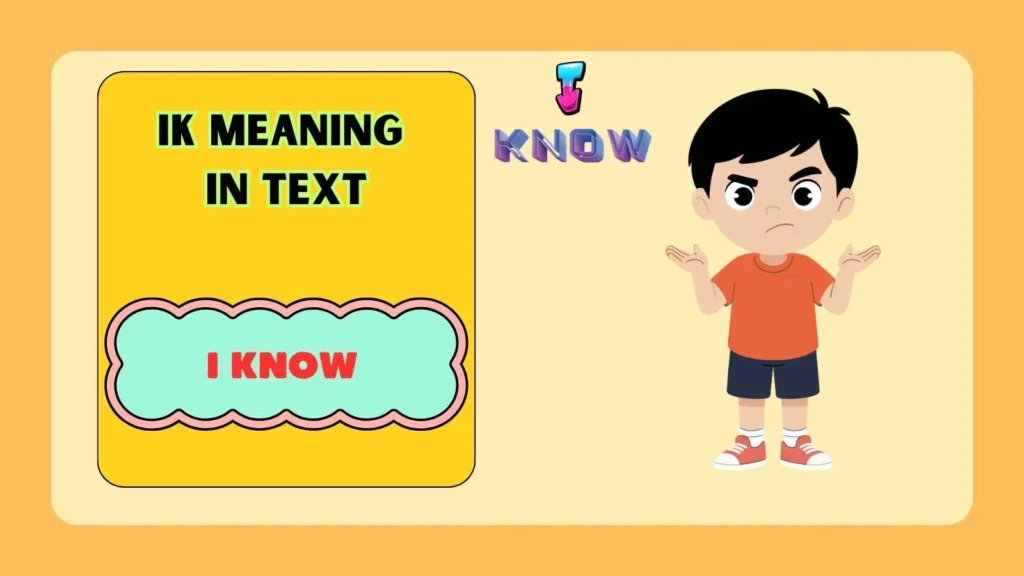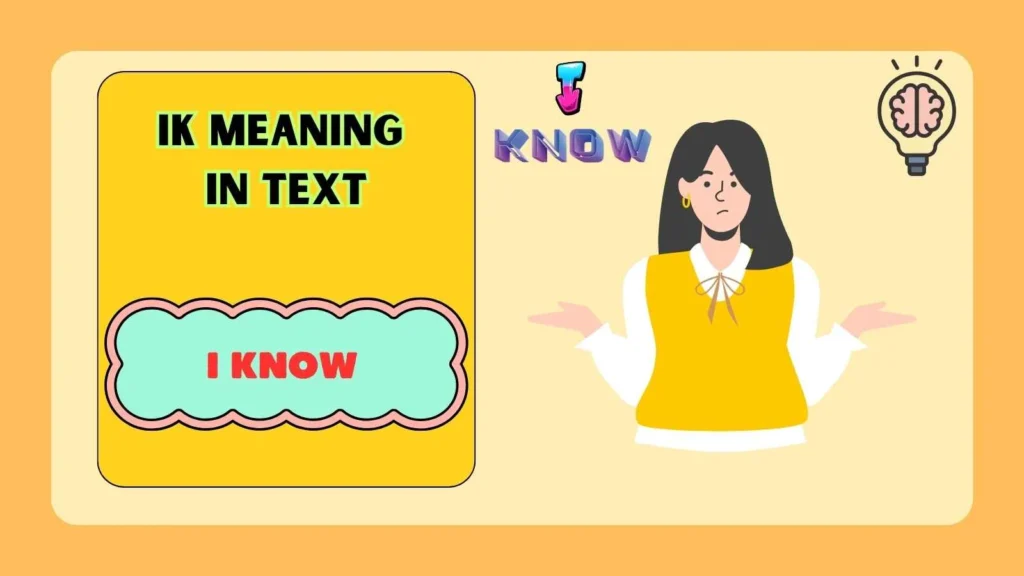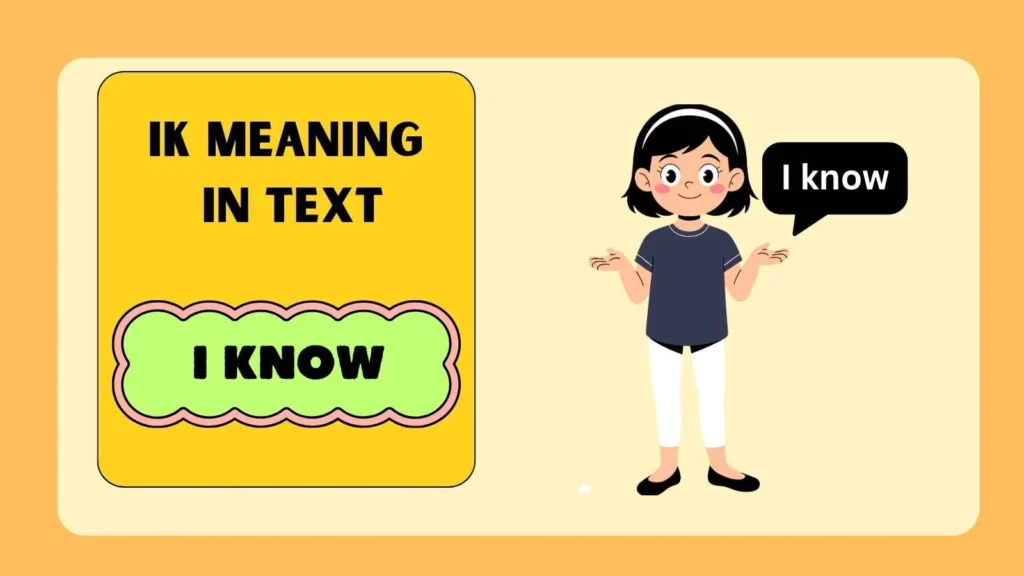Last updated on November 2nd, 2025 at 09:01 pm
If you’ve ever been texting a friend and received the short reply “ik”, you might have paused for a second. What does it mean, and why do people use it so casually in conversations? In today’s fast-paced digital world, shorthand expressions are everywhere, making it easier for people to communicate quickly.
Among these, “ik” has become a popular abbreviation, especially among Gen Z and Millennials. While it may seem simple, its meaning can vary depending on context, tone, and the platform it’s used on. Understanding “ik” in text messages is essential, as it helps you avoid confusion and interpret conversations accurately. I
n this article, we’ll break down the definition, usage, background, misconceptions, and alternatives of “ik”, while also explaining how to respond appropriately when you see it. Let’s dive deeper into everything you need to know about ik meaning in text.
Definition & Meaning
The abbreviation “ik” in text stands for “I know.” It’s one of the most common short forms used in casual conversations online and through SMS. The purpose of this abbreviation is simplicity—rather than typing out the full phrase, people shorten it to two letters for speed.
For example:
- Friend: “That movie was amazing.”
- You: “ik” (meaning “I know”).
It’s typically used to acknowledge a statement, confirm shared understanding, or show agreement. Tone, however, plays a big role. A casual “ik” may come across as neutral, while in certain contexts, it can seem dismissive if not paired with an emoji or additional words.
Background & History
Text abbreviations like “ik” originated from the early days of SMS messaging, where character limits pushed people to shorten words. Over time, these abbreviations migrated to social media, online forums, and eventually into modern texting culture.
“ik” emerged alongside other popular short forms such as “idk” (I don’t know), “brb” (be right back), and “omw” (on my way). The simplicity and universal understanding of “ik” made it a favorite across different age groups, though younger generations embraced it more quickly.
Today, it’s not just limited to texting—people use “ik” on Twitter, Instagram DMs, Snapchat, and even while gaming.
Usage in Various Contexts
“ik” can take on slightly different meanings depending on the tone and situation:
- Agreement: Used to confirm knowledge. Example: “The weather is so hot today!” → “ik.”
- Sarcasm: Can be playful or sharp depending on context. Example: “You’re always late.” → “ik 🙄.”
- Emotional Connection: Sometimes “ik” acknowledges feelings, showing empathy or understanding.
- Dismissive Reply: If overused, it may sound like the person is uninterested or cutting the conversation short.
Adding emojis or punctuation often changes how the message is received.
Common Misconceptions & Clarifications
- Not “I’m kidding”: Some mistakenly assume “ik” stands for “I’m kidding,” but that’s incorrect.
- Not professional: It’s not suited for work emails or formal communication.
- Tone confusion: Since it’s short, the recipient may read it as dismissive, even if the sender didn’t mean it that way.
Similar Terms & Alternatives
Other phrases people use instead of “ik” include:
- “yeah”
- “I knowww” (with extra letters for emphasis)
- “yep”
- “exactly”
- “true”
These can sound friendlier in some contexts, especially when tone matters.
How to Respond to This Term
If someone texts you “ik,” you can:
- Keep it short: Reply with “haha,” “fr” (for real), or “same.”
- Add detail: “ik, right? It’s so funny.”
- Show emotion: Use emojis to keep the conversation light.
Regional or Cultural Differences
While “ik” is widely understood in English-speaking countries, its use may be less common in regions where English slang is not as prevalent.
In some cultures, people may prefer full words instead of abbreviations. Younger generations, especially in the U.S., UK, and Canada, use “ik” more frequently compared to older users.
Comparison with Similar Terms
“ik” vs “idk”: “ik” means certainty, while “idk” shows uncertainty.
“ik” vs “brb”: “ik” is conversational, while “brb” is situational.
“ik” vs “yep/yeah”: All express agreement, but “ik” emphasizes knowledge rather than simply confirming.
Usage in Online Communities & Dating Apps
On platforms like TikTok, Snapchat, and dating apps, “ik” often appears in flirty or casual conversations. It’s used to show relatability or acknowledge a shared opinion. For instance:
- “You have the best taste in music.” → “ik 😉.”
In dating contexts, it can carry confidence or playful arrogance, depending on how it’s styled.
Hidden or Offensive Meanings
Generally, “ik” is not offensive. However, its shortness can feel cold or dismissive if misinterpreted. For example, replying only with “ik” after someone shares something personal might come across as uncaring. Adding context or emojis helps avoid misunderstandings.
Suitability for Professional Communication
“ik” is best avoided in professional spaces like work emails, academic writing, or business chats. Instead, use full expressions such as:
- “I know.”
- “That’s true.”
- “I completely understand.”
Using abbreviations like “ik” in formal contexts may appear unprofessional or careless.
📱 IK Meaning in Instagram

- 💬 IK means “I know,” a quick and casual way to agree on Instagram.
- ⚡ It helps users sound chill and effortless while replying fast.
- 📸 Mostly used in DMs or comments to show understanding.
- 💡 It keeps convos short while still sounding confident and friendly.
- 🧠 Gen Z and Millennials love it for its speed and simplicity.
- 💞 Often paired with emojis like 😌 or 😉 for emotional tone.
- ✨ “IK” fits Instagram’s laid-back vibe of short, trendy expressions.
- 🔥 Influencers use “IK” to sound relatable in replies or captions.
- 📲 The term shows social awareness and online fluency.
- 🌈 Using “IK” makes your messages blend with modern Insta slang.
💬 IK Meaning in Chat from a Girl

- 💕 When a girl says “IK”, it usually means “I know,” in a chill tone.
- 😊 It can sound sweet, teasing, or slightly sarcastic—depends on context.
- 💬 Sometimes, it’s a playful response to show she’s aware or confident.
- 💡 In casual chats, it keeps the mood relaxed and natural.
- ⚡ “IK” can also suggest she’s comfortable enough to keep it short.
- 😏 If paired with emojis like 😉 or 😌, it may hint at flirtation.
- 💭 When used bluntly, it could mean she’s ending the topic politely.
- 🧠 Always read the tone—“IK” can shift from friendly to distant easily.
- 🔥 Girls often use it when they already agree with or predicted something.
- 🌸 Overall, it’s confident, simple, and emotionally expressive slang.
🧩 IK in BI Meaning
- 💼 In Business Intelligence, “IK” can stand for “Information Knowledge.”
- 📊 It’s used in data teams to describe knowledge-based insights.
- 🧠 Analysts use “IK” as shorthand for shared data understanding.
- ⚙️ It connects well with BI tools that rely on information exchange.
- 💡 Sometimes used in technical documents or dashboards casually.
- 🌈 In sexual identity (BI) discussions, “IK” often means “I know.”
- ❤️ It signals understanding or support in identity-related chats.
- 🫶 It’s a friendly, validating response like “I understand you.”
- ✨ Whether in business or identity, “IK” builds connection and clarity.
- 🌍 Context always defines whether it’s about data or emotions.
😎 IK Meaning in Text from a Guy
- 💬 When a guy says “IK”, it usually means “I know,” but tone matters.
- 😏 Used casually, it shows confidence or agreement in a laid-back way.
- ⚡ Sometimes, it’s slightly flirty—like he’s teasing or acting cool.
- 💡 If the reply is short (“IK”), it might mean he’s not talkative right now.
- 🧠 Tone depends on relationship—friendly, sarcastic, or confident.
- ❤️ In flirty chats, it can imply understanding without overexplaining.
- 📲 Guys use “IK” to keep convos light and effortless.
- 🤔 If paired with “lol” or “😂,” it’s often meant humorously.
- 🕶️ It’s part of modern texting culture emphasizing casual coolness.
- 🌟 Reading context and emoji use reveals his real vibe.
FAQs
What does “ik” mean in text?
It means “I know.”
Is “ik” rude?
Not usually, but tone can make it sound dismissive.
Is “ik” used professionally?
No, it’s more casual and not fit for formal communication.
Does “ik” mean “I’m kidding”?
No, that’s a common misconception.
Do people use “ik” in dating chats?
Yes, it’s common in casual, playful conversations.
What’s the difference between “ik” and “idk”?
“ik” means certainty (“I know”), while “idk” means uncertainty (“I don’t know”).
Conclusion
The phrase “ik” in text may look simple, but it carries layers of meaning depending on tone, context, and intent. From casual chats with friends to witty exchanges on dating apps, it helps people communicate faster and with less effort.
However, understanding how it can be misinterpreted is key to avoiding confusion. While “ik” works perfectly in informal spaces, it’s not suited for professional or serious communication. By knowing when and how to use “ik,” you’ll navigate digital conversations more effectively.
